Our bedrooms are our safe haven, made for providing the atmosphere we need to refuel and replenish from a hard day’s work.
Our body needs good sleep to revive and repair to be able to keep doing all the awesome things we do. We work, parent, teach, motivate, mentor, guide, we even play, and at the end of the day, sleep calls. And if it’s not quality sleep, we never feel fully replenished.
That’s why everything in the bedroom space needs to foster an atmosphere of good, quality sleep. Even the color of the bedroom needs to say, ‘sleep.’ So what are the best bedroom colors for sleep?
Blue is the best color for sleep, followed by yellow, green, silver, orange, pink, white and beige. The worst colors for sleep are purple, brown, red and black (black having some mixed reviews). For optimal sleep go with a color that make you feel relaxed and calm.
Keep reading to learn the psychology behind colors, how they can affect your sleep, and the best and worst colors for the bedroom.
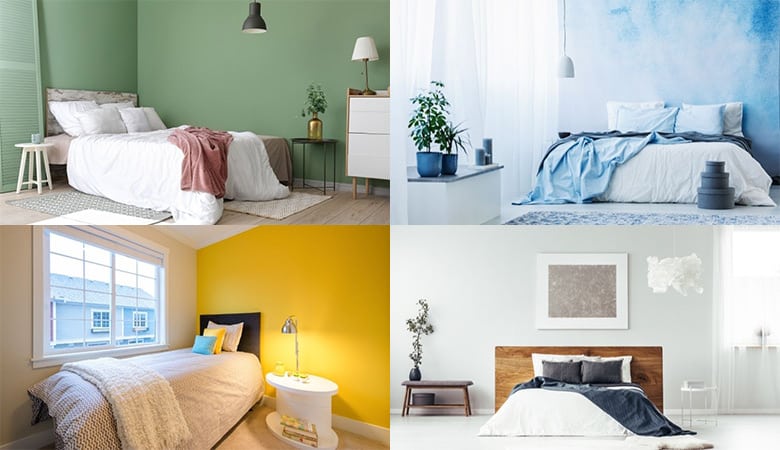
The Psychology Behind Colors
Colors influence our emotions and state of mind. They impact our mood, which makes us behave a certain way.
Take red for example, red is a color that researchers have found gets the adrenaline flowing within us. That’s the reason bullfighters use a red cape and the reason why targets are red. Red increases passion. It angers us and excites us. It’s that color that takes us to the extreme within, be it good or bad. Colors also implicate the taste of our food or how warm or cold something feels.
Here’s a graphic explaining what each color means to us:
It helps to know how colors affect you overall, so you can situate your atmosphere for optimal sleep. For instance, if red is going to have your emotions all over the place, you may not want to see that displayed all over the walls right before going to bed.
How Does Colors Affect Sleep?
Having colors in your bedroom that foster calmness and promote positive energy flow is what works best to get quality sleep. This means toned down or muted shades will work better for sleeping than vibrant colors.
The Best Bedroom Colors for Sleep
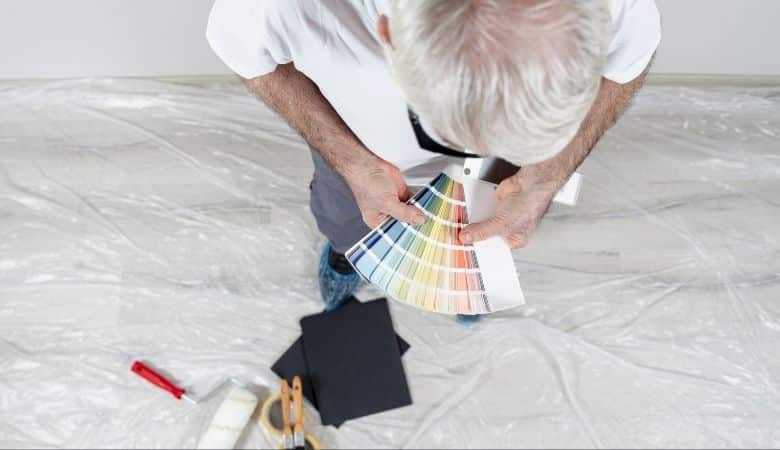
The best colors for sleeping are the shades that make you feel relaxed and calm. Relaxing and calm is always what you’re going for when you lay down and put your head on that pillow. Your intention is to relax your body, calm your nerves and go into an uninterrupted neverland of peace of tranquility. Here are the best colors to help you do that:
Blue
Blue is the absolute best color for sleeping. The sky is blue; the sea is blue. This is because blue is calming, and calm is what you need for a good night’s sleep.
Also, our brain is especially receptive to blue due to special receptors in the retinas. It picks up on this color and automatically reacts to its calming effect and puts us in the mood for sleep.
The color blue invokes calmness, serenity, trust, and stability. When choosing a blue for your bedroom, consider a light shade that reflects the clear blue sky.
Blue bedroom example:
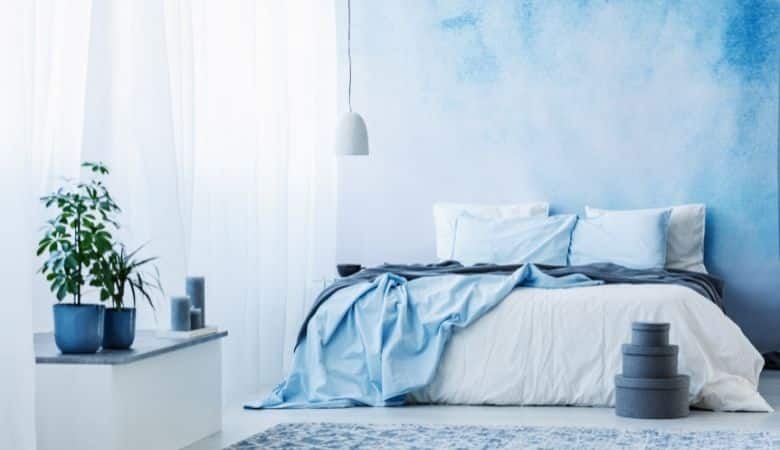
Yellow
Yellow is also good for sleeping. This soft shade creates a tranquil environment because the muted tone connotes happiness and sunshine. It alleviates stress, and you wake up feeling rejuvenated and with a new boost of energy.
Now, there are many shades of yellow, and if you’re looking to go with yellow for your bedroom, then a darker shade is the best option, simply becuase it’s calmer.
Yellow bedroom example:
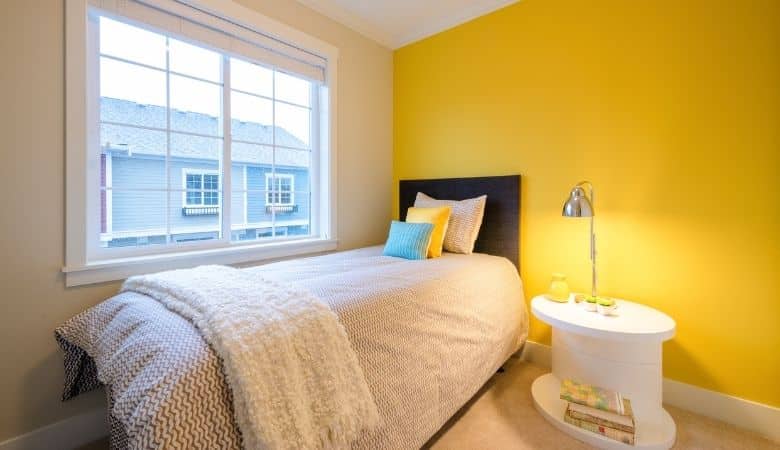
Green
Green is organic and connotes a feeling of nature. This helps to produce a calming effect associated with calmness and tranquility, which makes for ideal sleep.
When choosing a shade of green for your bedroom, consider sage. Sage evokes images of gardens, grass, and nature itself. Adding one or two small, green plants to the bedroom is another way to invoke that green into your bedroom, regardless of the color of the walls.
Green bedroom example:
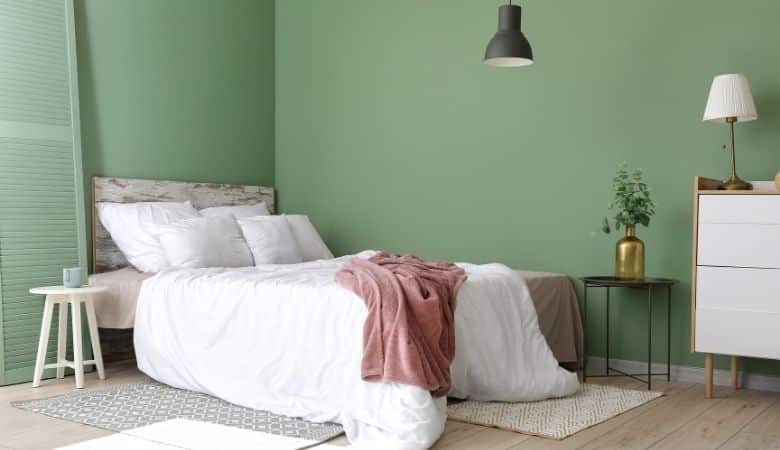
Silver
If you’re not into a lot of colors and prefer something more neutral, you’ll be happy to know that silver is also a good shade for sleeping. It connotes that same feeling you get on a foggy or rainy day, and you just want to stay in bed and curl up with some relaxing tea.
Be cautious, this is a tricky color, and it can be hard to find the perfect shade. So be sure to view paint samples in natural and indoor light before making a final decision.
Silver bedroom example:
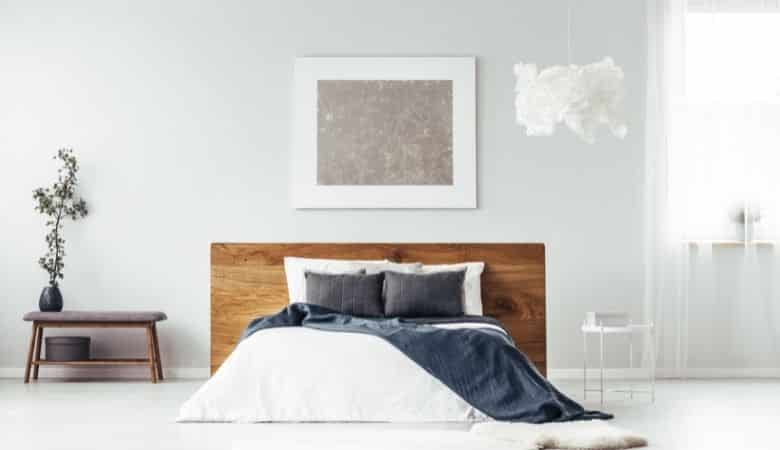
Orange
Orange has a warm tone that mimics a sandy beach, creating a welcoming space in your bedroom. The color orange is also believed to help with indigestion. For some of us, this is a recurring problem or one we face from time to time. Imagine, just changing your bedroom color to orange could help with that.
When choosing orange for your bedroom, choose a shade with brown undertones like terracotta, rather than bright orange. The undertone makes it more neutral and that’s what makes the color so relaxing.
Orange bedroom example:
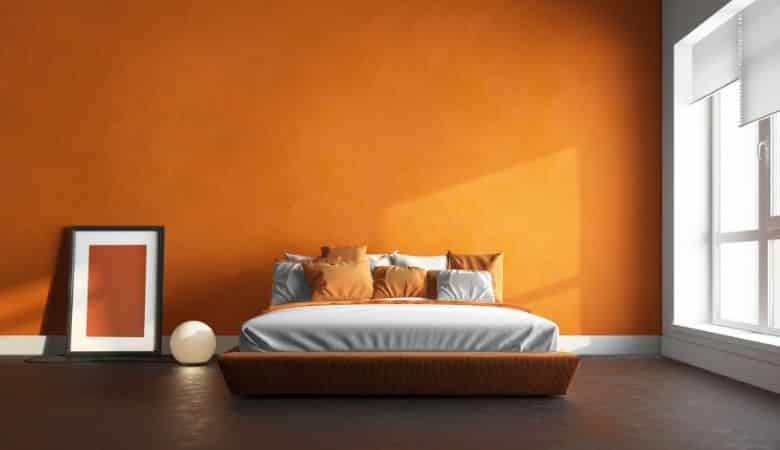
Pink
Soft, light pink is a good choice for bedroom color. A soft, natural pink tone is comforting, and because it’s so close to our skin tone, it gives a calm, zen-like feeling. Pink represents a gentle tenderness; it’s calming and can be linked to a naive sweetness.
If your life is kind of stressful, pink can help you sleep at night. When choosing pink for your bedroom, please avoid hot pink; that’s too close to the red family, which we definitely want to avoid before bed. Go with a light, barely-there shade and mix in other soft colors for the bedding and upholstery.
We understand not everyone wants pink walls in their bedroom. So even if you choose a color other than pink, consider having a blanket or pillow in pink.
Pink bedroom example:
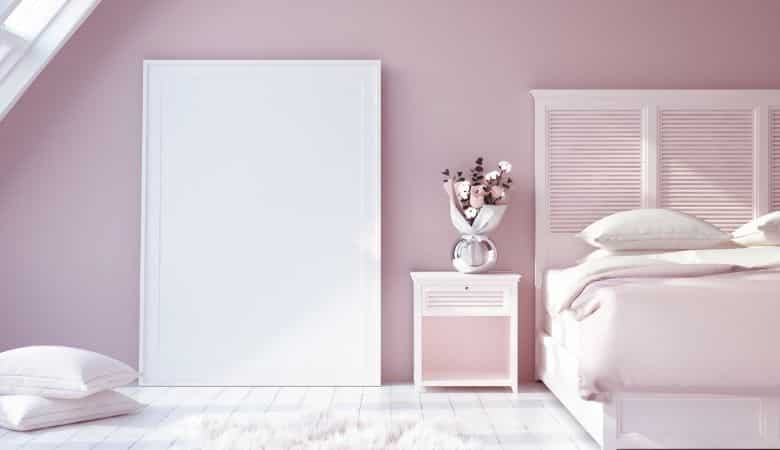
White
White is the lightest color on the spectrum. It’s a symbol of serenity and peace which makes it perfect for the bedroom. White is clean and polished and usually the color of choice for homebuilders.
So if you’re starting with white walls in your bedroom, think carefully before deciding to paint over them. There are different variations of white, from cream to every shade in between, and they’re all restful to tired eyes.
White is easy to spruce up or embellish. You can add floral or lace-edged bedding for more appeal. You can go anywhere you want to go with the decor.
White bedroom example:
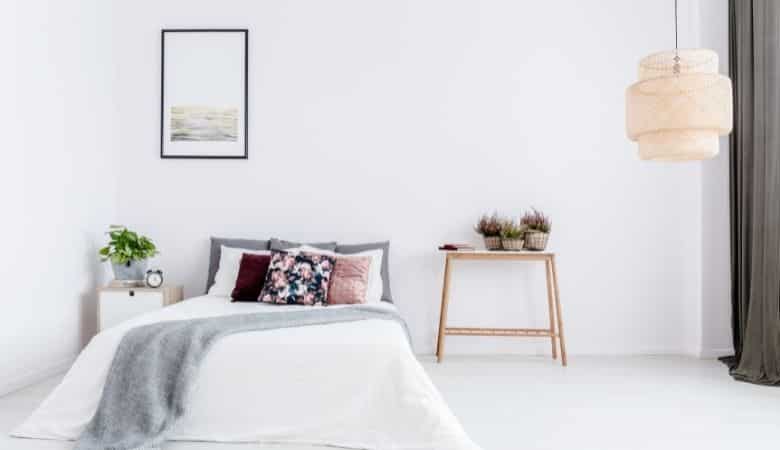
Beige
Beige has a light, natural hue that makes it an appealing option for interior design. It’s a bit warmer form of white. Because it’s so similar to white, it also represents serenity and simplicity. It’s plain and quiet and a perfect complement to sage green.
When choosing beige for your bedroom walls, consider a warmer tone of sand and straw that will glow in the lamplight and beautifully reflect the morning sun. That’s even more welcoming to your morning.
Beige bedroom example:

Black
This is a color you probably weren’t expecting to see, and actually, this color could go either way. So we’ll tackle why some experts do see this as a good color for the bedroom and why others don’t.
The color black connotes the night sky; thereby, immediately getting you in the mood for sleep. There are different shades of black, from warm charcoal to gray to jet black, so decide the shade that works best for you.
You can also combine black with white fabric and furniture, giving a perfect delicate black-and-white combination that will soften the overall black effect.
Black bedroom example:
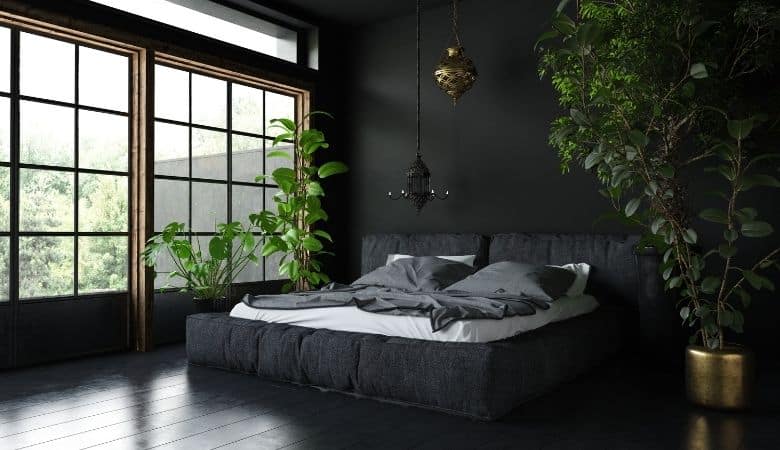
The Worst Bedroom Colors
Purple
Purple is stimulating and increases creativity. This might be great during the day when you need that, but at night it keeps the mind awake.
It’s likely to even produce vivid dreams or nightmares that could result in you feeling restless in the morning. Many of us love the color purple, so If you have to have purple, consider a shade with cool undertones, like lavender instead.
Purple bedroom example:
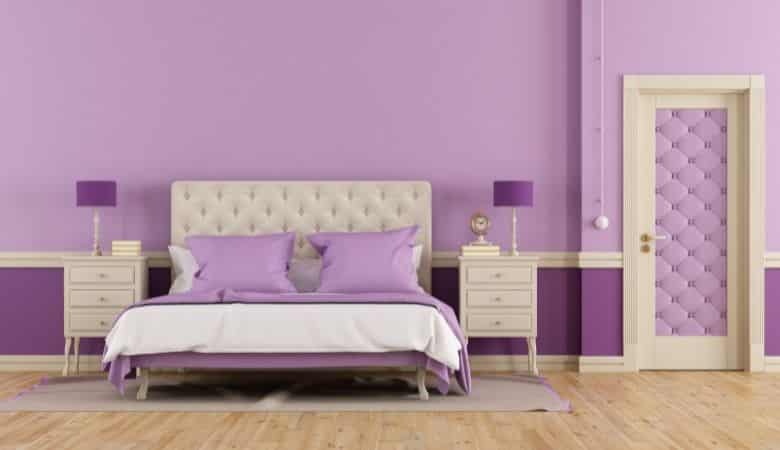
Brown
Brown is dreary and depressing. It increases your feeling of anxiety and being isolated and ends in restlessness. Rather than brown, consider a lighter color like beige or cream.
Brown bedroom example:
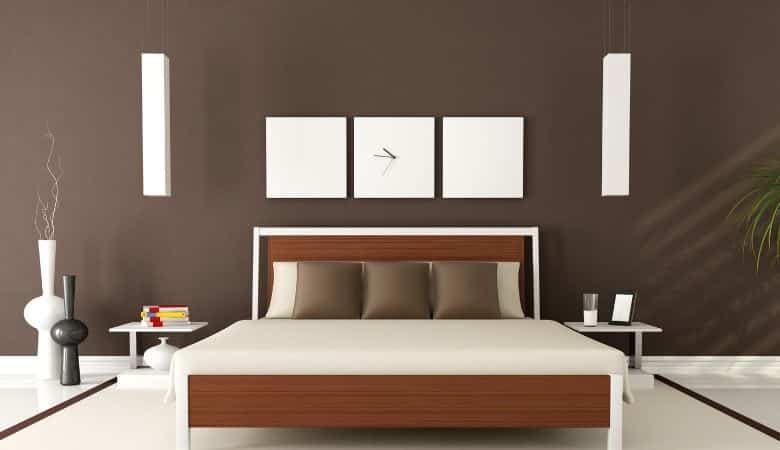
Red
Red is passionate and energetic. It increases your blood pressure and causes you to move faster. This is certainly okay if you’re in a race of some sort. However, red can also provoke aggression or anger. Because of its intensity and how it can push you to the extreme, it isn’t exactly a good lead-in to a good night’s sleep.
With that said, certain shades of red such as Sangria is a good option for the bedroom. According to craft-art this unique color it’s known to make a room feel cozier and friendlier, which of course is great in a bedroom.
Red bedroom example:
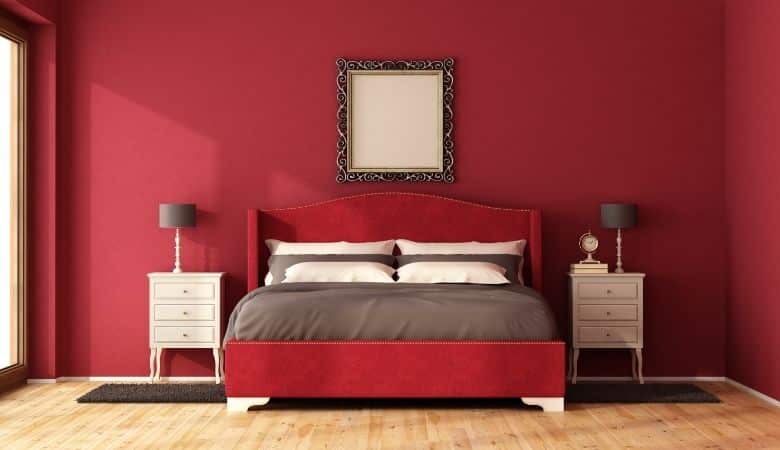
Black
This one has mixed reviews. For reasons stated above you read why black may be a good color to have in your bedroom. Now, you’ll hear why some feel it’s not.
Some experts feel that black promotes feelings of negativity, including anger, fear, sadness, and even death. Seems they all agree that black can be used sparingly to create a more calming effect in the bedroom. They recommend that instead of choosing black bedding, sprinkle black accessories throughout the room, from picture frames to candles to plant holders.
Other Color Tips for Optimizing Sleep in Your Bedroom
Once you have your ideal sleep color picked out for your bedroom, you want to ensure your room is set up for optimal sleep overall. Here are some additional tips to help you get that quality sleep your body needs.
- Change your bedding colors from time to time to reflect more sleep-inducing shades.
- Whatever color you decide to go with, know that soft, natural, and muted colors are best for sleep.
- Don’t be afraid to add accents — just ensure it’s not too vibrant.
- Stick to flat paint for the bedroom. Avoid eggshell and gloss finishes because these finishes reflect light.
Related Questions
What color light helps you sleep? Warm light is better for sleep. This means light bulbs with a yellow or red hue are best for bedside lamps.
Are white sheets a good color for sleep? White is a neutral color that has a relaxing effect, so this is an excellent color for sleeping on. Pairing it with other colors conducive to sleep is another great option.
What colors make a room look bigger? Soft shades and natural colors really help to make a room look larger than what it is. Consider light blues, pale greens, and off-white to help make that studio room or one bed-room apartment look a little bigger. If you have molding, you could also consider painting them a lighter color than the walls to help give the illusion of a larger room.
Conclusion
The color of your bedroom does affect how well you may or may not sleep at night. While blue is the best color for a relaxing night’s sleep, there are other colors that may work just as well. The key is finding the color that best fits your room and your decor.
Take care in deciding what colors to choose for your bedroom accents. All of your colors should complement each other.
